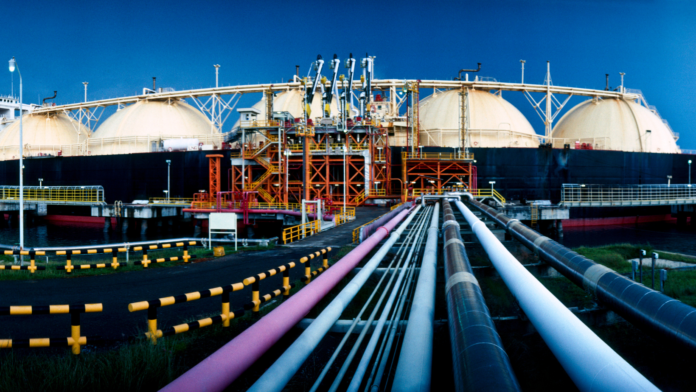Residents of coastal Louisiana are facing growing risks from flooding and extreme weather, with options for home insurance vanishing as insurers leave the state. But the fossil fuel industry operating nearby has no such worries.
Liquified natural gas (LNG) terminals have been springing up along the fragile Gulf Coast, securing insurance even as their product contributes to the climate crisis and its growing risks, including more intense hurricanes and increased coastal flooding that are driving away residents.
The difference is scale: For large projects such as LNG terminals, risk is spread among many insurers. No one company is exposed to all of a terminal’s potential losses. The same is not true for insurance companies whose business is built around residential policies where hurricane damage can lead to millions of dollars of claims at once.
But that outcome is more than an actuarial calculation for residents: when Hurricane Ida made landfall in southeastern Louisiana in 2021, an eight-foot storm surge swept over a six-foot Mississippi River levee in Ironton, flooding and destroying much of the small town, even dislodging caskets from their tombs.
Damage from Ida sent Louisiana’s property insurance market–already rattled by three major hurricanes in two years–into a full-blown crisis. By the end of 2022, nearly two dozen insurance companies had either left the state or gone under.
Residents scrambled for new, dramatically more expensive coverage or went without.
Meanwhile, just a few miles south of Ironton, a massive $20bn liquefied natural gas terminal is rising on a wedge of land between the Mississippi River and encroaching wetlands. Plaquemines LNG is one of eight terminals built or planned along Louisiana’s coastline.
“People who can leave have left,” Byron Encalade, president of the Louisiana Oystermen Association, says of his life-long home, Plaquemines Parish, which includes Ironton.
“The insurance situation is just horrible. People still haven’t been paid fully for the damage [from Ida],” Encalade said, adding with skyrocketing costs, some homeowners are paying more for their insurance than their homes.
The three parishes in Louisiana where LNG terminals are concentrated have all seen significant population decreases in the past two years, primarily driven by hurricanes.
As more residents leave, the parishes are less able to invest in the infrastructure that makes coastal communities livable, including schools, driving even more people away. “Over time it will diminish the fiscal capacity of the parish in terms of tax revenue to even recover next time,” Jesse Keenan, a professor of sustainable real estate at Tulane University, says. “Forget plan or prepare.”
“These parishes have terminal cancer, in the sense that these hurricanes are going to continue in their frequency and their intensity in ways that are really unprecedented,” Keenan says. “Insurance companies are aware of that.”
GET THE MORNING HEADLINES DELIVERED TO YOUR INBOX
‘A very certain present’
Both chronic and extreme events connected to climate change will expose the oil and gas industry on the Gulf Coast to more risks over the next two decades, says Andrew Coburn, CEO of climate analytics firm Risilience.
A review of data of existing and planned LNG sites in Louisiana from risk assessment non-profit First Street Foundation showed either severe or extreme flood risk—meaning there’s a high likelihood of water reaching the centre of each site in the next 30 years—as well as extreme wind risk.
Coastal Louisiana has always been in the path of storms, but it’s clear to Alex Kolker, a coastal geologist at the Louisiana Universities Marine Consortium, that more extreme weather is not only the state’s uncertain future: “It’s a very certain present.”
Warmer oceans and warmer air, Kolker says, provide more fuel for hurricanes, leading to stronger storms with more intense rains and harsher winds. Rising oceans raises the average level of the shoreline. “In Louisiana that’s compounded by the fact that the land is sinking, and it’s sinking relatively rapidly,” Kolker says.
While many of the world’s largest insurance and reinsurance companies have emissions targets and no longer insure coal projects, they have resisted calls to stop insuring fossil fuel projects entirely, despite their contribution to climate change and increased global risk.
At the same time, state legislatures and Republican attorneys generals have threatened insurance companies for using environmental criteria when setting rates, spooking major insurers away from a UN-backed effort on cutting emissions.
The companies no longer insuring Louisiana homes are well-known, but those insuring LNG terminals are not. Government agencies require proof of insurance for fossil fuel projects, but those documents are often shielded from the public as developers claim confidential business information exemptions, even going to court to prevent insurers’ names from becoming public.
In early June, anti-fossil fuel campaign Insure Our Future got a rare look into one gas export terminal in Texas: Freeport LNG. First published in E&E News, Freeport’s insurers are largely specialty or reinsurance companies, but a few are also involved in the property market, including Liberty Mutual, AIG and Chubb.

































